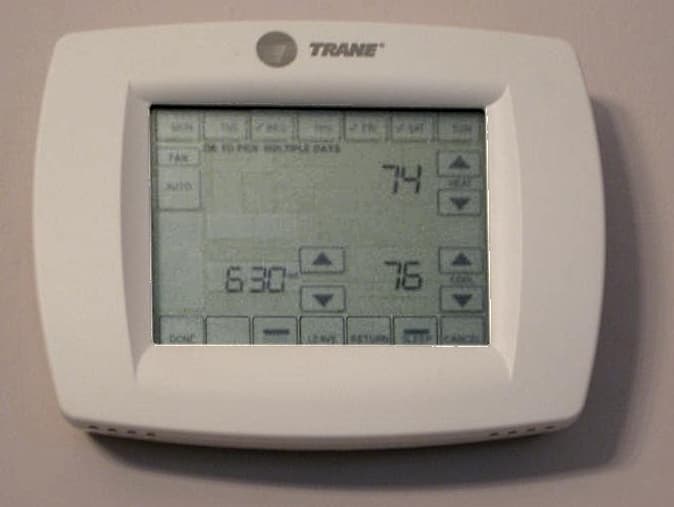
Enjoying a comfortable temperature within your home is something difficult to compromise on. That's why it's essential to carefully choose your thermostat. But, what exactly are the options available on the market and what are their main features?
Different Types of Thermostats
Mechanical thermostats (bimetallic or roller)
In case your house isn't newly built, it's likely that mechanical thermostats are a feature. Mechanical thermostats, also known as roller or bimetallic thermostats, are very aptly named. In fact, they're made up of a roller dial and a casing with two blades (one fixed and one adjustable). The latter is made of two metals with different degrees of expansion.
But, how exactly do these affordable thermostats work? When the temperature of the thermostat drops, the two blades are activated causing their ends to touch. This reaction turns on the heating system. When the temperature reaches the desired level, the blades separate and the system switches off.
The reason why this heating technology is increasingly less common is due to several significant drawbacks. First off, mechanical thermostats are less receptive to temperature variations than programmable thermostats, and will often vary the temperature by 2 to 5 degrees. This means that it's usually necessary to raise or lower the temperature, which means that it always feels either too hot or too cold.

Photo: Wikipedia
The second concern is that these thermostats aren't exactly known for their swiftness. As a result, you have to be patient before you can enjoy a more comfortable room temperature. Let it be known that its mode of operation can sometimes cause baseboard heater blades to contract or expand.
However, remember that such a thermostat can nevertheless be useful in certain situations. If your heating system is powered by an unstable electrical source, a mechanical thermostat can prevent the system from overheating.
Electronic Thermostats
Standard electronic thermostat (non-programmable)
The electronic thermostat is powered by a pulsation controller and provides a temperature reading every 15 seconds. These readings, which are taken at frequent intervals, allow you to enjoy a stable room temperature, reducing both energy losses and discomfort. In this respect, let's say that the use of electronic thermostats can save between 4% and 10% of your heating costs. When choosing your new thermostat, don't forget to take into consideration the strength of your baseboard heaters.
Note that if you have a heat pump, it can be controlled by either an indoor or outdoor thermostat. If your thermostat is located outside, you have two options, the first of which is a model used for air-source heat pumps. This model automatically shuts off when the temperature drops below a set temperature. The second model, on the other hand, is mainly used for standard heat pumps and regulates the activation of the unit according to weather conditions.
Programmable electronic thermostat
While it works in a similar way to that of a standard electronic thermostat, the programmable model offers better temperature control than the former. The programmable model offers the possibility of automatically adjusting the temperature in each room using a timer, with the option of variable programming. This means of temperature control and the flexibility offered by this system can considerably reduce heating costs (between 4% and 5% per 3 degrees Celsius over a period of 8 hours).
While some people are already thinking about the considerable savings they could make by drastically reducing indoor temperatures during their absence, note that this practice can have negative repercussions, including increased humidity and condensation problems, if not present already.

Photo: Wikipedia
Since this type of thermostat is more expensive than the non-programmable model, note that installing it in a home in which the temperature doesn't need to be adjusted throughout the day is an unnecessary investment. Therefore, a non-programmable model is likely to be more than sufficient.
It's also important to note that certain models offer the possibility of configuring a weekly temperature (from Monday to Friday) and another one for the weekend. Other models allow you to set three temperature levels: one set for weekdays (Monday to Friday), one for Saturdays, and one for Sundays.
Smart thermostat
The name alone is enough to convince anyone that this thermostat is the most sophisticated of all. Being manageable remotely, the smart thermostat allows you to benefit from optimized temperature control. When connected to your home's wireless network, it can be controlled from a tablet, laptop, or smartphone.
On top of this highly desirable advantage, the versatility of this type of thermostat is also a real asset. In fact, this type of thermostat can be used with electric baseboards and convection heaters, and with a forced-air central heating system or a heat pump. Air conditioning, heating, ventilation, and humidifiers, nothing is immune to its use!
Although it's commonly talked about because of the previously mentioned features, remember that the smart thermostat itself changes both the heating and air conditioning levels according to weather fluctuations. It's possible to control this automated setting through notifications when temperatures rise or fall below preset levels, thus allowing you to readjust these specific room temperatures. Interestingly, the smart thermostat collects data related to your temperature control habits and can, depending on this data, make this control more efficient for you.
It's an option which offers a perfect balance between autonomy and control, making this thermostat a choice few people regret. For those who want to keep an eye on their energy consumption, the smart thermostat provides constant monitoring, thus helping you maximize your efforts to reduce your heating bill. Note that this objective can only be reached if you take advantage of the programming function.
As you might imagine, this type of thermostat's advanced features come with a higher price tag, up to four times the price of a conventional thermostat. Therefore, it's essential to weigh the pros and cons of your purchase, especially since temperature programming isn't an essential feature if a constant indoor temperature is convenient for you.
Still, this feature can help you save on your heating bill, which can eventually pay off your initial investment. If you wish to purchase one, you may be a tad overwhelmed by the complexity of the installation process. Therefore, it's often best to hire a qualified heating technician to handle it.
Thermostats In a Nutshell
Types of thermostats | Mode of operation | Pros | Cons |
|
|
Mechanical (roller/bimetallic) |
|
|
| ||
Electronic, non-programmable |
|
|
| ||
Electronic, programmable |
|
|
| ||
Smart |
|
|
|
Get 3 renovation quotes for your air conditioning and heating project
RenoQuotes.com can help you get quotes for your air conditioning and heating project. If you submit your project, we’ll put you in contact with top-rated contractors. Fill in the form on the homepage (it only takes a few minutes), and you will get estimates from trusted professionals.
Dial 1-844 828-1588 to speak with one of our customer service representatives.
Looking for something else?
Related articles
The latest industry news, interviews, technologies, and resources.

Cynthia Pigeon
•12 Jul 2024
Is your kitchen clad with melamine cabinets and looking duller than ever? Have you forgotten the last time you redecorated your kitchen? Either way, your cabinets are robbing you of your love of cooking and you sure don't want to miss out on new storage ergonomics. So it's about time you give your kitchen some pizzazz!

Editorial Team
•03 Nov 2025
Most people know about acrylic paint and acrylic mediums or have heard of water-based paints. However, few actually know what acrylic pigments actually entail. As a matter of fact, when undertaking a renovation project, we often find ourselves faced with obscure terms that are hard to grasp at first.

Editorial Team
•01 Oct 2024
A common misconception is that it is best to plan home renovations in the summer, rather than during other parts of the year. Although certain tasks, such as paving an entrance or inspecting a roof, require conditions that are specific to the warmer season, in many cases, renovating during the winter can prove to be a good option.

Editorial Team
•07 Nov 2023
Everyone loves natural light as it pours into the home during spring, summer, fall or winter. However, not every house is lucky enough to be blessed with full sun and therefore, some rooms are left darker than others. Luckily, there are ways to work around living in a dark home with a few optical illusions and design tips that can help you redesign and rearrange for instant brightness.

Editorial Team
•07 Apr 2025
Be honest, we spend most of our time indoors rather than outside, admiring the landscape from afar. Nevertheless, the exterior of your home is very important.